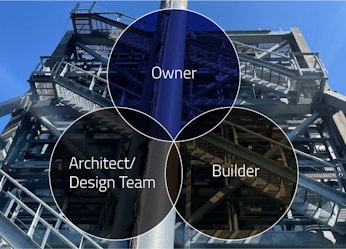

M|O Perspectives
Check back here for our thoughts on the latest developments in our industry.
Inside the Evolution of Design-Build
Sep 29, 2022
Construction isn’t known for being an efficient process. Why? Because building a structure is subject to so many vagaries: weather, labor, logistics, market forces, pandemics, material availability, and a host of other factors that can impact any construction site.
It’s no surprise, then, that we're seeing a variety of delivery trends aimed at working around these risk factors and creating new efficiencies. For example, we have previously written about modular/prefabrication construction and the attempts to bring it to scale with varying degrees of success. But let’s focus on another project delivery trend that has been building momentum over the last two decades: design-build (DB).
Types of traditional design-build project delivery
Building construction teams employ numerous variations of project delivery methods. One of the most recognizable is traditional design-build (DB). In DB, the owner contracts directly with the design team/architect to develop the design for their building, giving the owner with the most control over the project design by establishing a direct relationship with the architect/design professional. The architect works with the owner to design the building, meeting the owner's program, budget, schedule, and aesthetic requirements. The project is bid out, and usually, the lowest qualified bidder is selected, a construction agreement is executed, the selected contractor/builder delivers the completed building to the owner, and everyone lives happily ever after.
Unfortunately, that doesn't represent reality. In some cases, the low-bid environment creates an adversarial relationship between the architect and the builder, resulting in delays and cost overruns, with the owner caught between the two. This can leave the owner feeling frustrated that the initial budget and cost estimates did not truly reflect the final project costs and in some cases, the material quality of the finished product isn't close to the fancy renderings that were created during the design phase.
One project delivery method that attempts to remediate this issue adds pre-construction services. In this case, the general contractor is brought on early on the job to provide pre-construction services and to assist with the development of preliminary hard cost estimates. While the tendency is to utilize the same contractor during the construction phase, the owner has the prerogative to bid out the project to other contractors.
Construction manager at risk (CMAR) is another project delivery model. In this case, the construction manager is contracted to deliver the project at a guaranteed maximum price (GMP) and acts as a consultant during the pre-construction/design phases, and reverts to a traditional contractor role during construction. Other variations of this method include construction manager multi-prime (CMMP), which allows for the owner to remain heavily involved with the project by holding several contracts with various contractors and subcontractors while utilizing the construction manager (CM) as their consultant to manage the entire process.
In both cases above, the architect's contract and relationship are with the owner, but the construction manager manages the relationship with the intent of a more collaborative process. Under the multi-prime model, the owner procures contracts with multiple contractors for various portions of the construction work (i.e., general conditions, earthwork, mechanical, electrical, plumbing, or framing/structural). The construction manager controls the project schedule and budget and oversees the pre-construction/construction contractors.
The advantage of this project delivery process is the builders are involved early in the project and provide input on constructability and cost throughout the design process. Once construction begins, administrating the overall process can be difficult, with unclear definitions of where each trade’s scope of work ends and can result in some overlaps or gaps.
Traditional design-bid-build vs. modern design-build
In all the examples above, the owner is looking for a way to better manage the overall project, including budgeting, scheduling, and fostering a collaborative or integrated approach to project delivery. Design-build is an attempt to provide a project delivery method superior to the traditional DBB process—and an improvement over the construction manager's multi-prime delivery process.
The overarching idea is to involve both the builder and the architect from project inception through completion, improving collaboration and providing the owner with a single point of contact and a simplified contractual relationship. It is essentially a turn-key method of project delivery that provides better control over the risks for the owner.
To achieve this goal, a temporary, project-specific design-build entity (DBE) is created, where the builder and architect join forces. The DBE is able to take on more of the risks during design and construction, ultimately minimizing the owner's administrative and overhead costs for managing the project.
Two-step DB procurement process
In the design-build process, the owner may choose to select a “bridging” architect to develop criteria or bridging documents that capture the owner's program, vision, and goals. Owners then select the design-build entity based on the bridging documents. Owners usually obtain the services of a DBE through a two-step process that starts with a request for qualifications (RFQ) in which the owner will review and shortlist what they believe to be the most qualified DBEs. A request for proposals (RFP) is subsequently issued to the shortlisted teams, with the bridging documents as the basis for their design ideas and development of the proposed GMP.
The second step, RFP, may include a design competition with a stipend and consists of a series of meetings where the DBEs and owner discuss the merits of the proposed design and construction budget. The owner then selects a finalist DBE and contracts with them utilizing the GMP that the winning team proposed. Some owners may decide to forgo any bridging documents or competitive selection process and negotiate directly with a DBE before contracting with them.
Once selected and under contract, the DBE proceeds with design development, construction documents, and bids out the project within the GMP ceiling. Without bridging documents, the guaranteed maximum price is set during the schematic design or design development phase. The intent is to minimize change orders, project scope creep, and schedule impacts through the DB process.
We hope this gives you better insight into the evolving design-build process and how it may impact projects you’re involved in or may need to manage as an owner. If you have any questions on navigating this process, please contact Gerard_Lee@marxokubo.com. Stay tuned for a related topic on how design-build is currently being leveraged in multifamily projects throughout the country.

What we do.
- Owner's Representation
- Property Condition Assessment
- Project Management
- Constructability Reviews
- Repair | Reconstruction
- Facility Condition Assessment
- Construction Loan Monitoring
- Accessibility
- Building Enclosure
- Fire | Life Safety
- Mechanical | Electrical | Plumbing
- ESG | Sustainability & Resiliency
- Structural Engineering
- ASAP® - Automated Structure Alert Program
Marx|Okubo is a national architecture/engineering/construction consulting firm that works with real estate owners, investors and lenders—at every point of the property lifecycle—to evaluate their building projects, solve complex challenges and implement tailored solutions. We help clients understand their projects’ complexities, so they can make more informed decisions and, ultimately, mitigate their risk.




